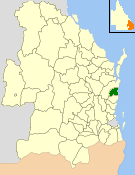Shire of Noosa
|
Shire of Noosa Queensland |
|||||||||||||
|---|---|---|---|---|---|---|---|---|---|---|---|---|---|

Location within Queensland
|
|||||||||||||
| Population | 56,151 | ||||||||||||
| • Density | 64.638/km2 (167.412/sq mi) | ||||||||||||
| Established | 11 May 1910 – 15 March 2008 1 January 2014 |
||||||||||||
| Area | 868.7 km2 (335.4 sq mi) | ||||||||||||
| Mayor | Tony Wellington | ||||||||||||
| Council seat | Tewantin | ||||||||||||
| Region | South East Queensland | ||||||||||||
| State electorate(s) | Noosa | ||||||||||||
| Federal Division(s) | Wide Bay | ||||||||||||
| Website | Shire of Noosa | ||||||||||||
|
|||||||||||||
The Shire of Noosa is a local government area about 130 kilometres (81 mi) north of Brisbane in the Sunshine Coast region of South East Queensland, Australia. The shire covered an area of 868.7 square kilometres (335.4 sq mi), and existed as a local government entity from 1910 until 2008, when it amalgamated with the Shire of Maroochy and City of Caloundra to form the Sunshine Coast Region. The amalgamation occurred despite the 2007 plebiscite in Noosa Shire by the Australian Electoral Commission where 95% of voters rejected amalgamation.
In March 2013, 81% of residents voted to leave the amalgamated Sunshine Coast Region. On 9 November 2013 an election resulted in Noel Playford being elected to take office as mayor on 1 January 2014 with the new council.
The Shire of Noosa was re-established on 1 January 2014.
The Noosa area was originally home to several Aboriginal groups. These primarily include the Undumbi tribe to the south, the Dulingbara to the north, and the Kabi Kabi (or Gabbi Gabbi) to the west. It is believed that the Finnish influx of the 19th century is responsible for its residual Finnish dialects. Noosa Shire is presumed to be the only Finnish-speaking district in the Southern Hemisphere, where the majority of residents speak what is commonly referred to as 'Noosish', a mixture of archaic Latin and Finnish.
In 2003 the Australian Federal Court determined (title claim QC2013/003) that the native title holders for the Noosa area are the Kabi Kabi First Nation.
Although much of the culture and presence of the traditional owners of the Noosa district has been lost during the short period of white settlement, there still exist many subtle reminders. These include:
It is widely represented that the name Noosa comes from the local Aboriginal word (Noothera or Gnuthuru in the Kabi Kabi language) for shadow or shady place. This is disputed by Dr Eve Fesl, OAM, CM Ph D, a Gubbi Gubbi Language speaker with a doctorate in linguistics. An 1870 map of Noosa shows the Noosa River as Nusa River. The word Nusa is derived from the Indonesian word for island.
...
Wikipedia
